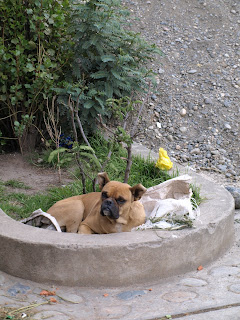Contrary to what many of my friends in Huaraz may think, I actually went to work at the office of the Mountain Institute almost every day, and after a while I got to be quite familiar with the neighbourhood, and it's inhabitants.

I would pass by the same old men on the street, who would greet me every day with a smile; "buenas dias gringa!"

The teenagers on the street , being well, as teenagers are everywhere,

and I would pass people in their gardens, filled with plants that would remind me of Cyprus; bourgainvillier, geraniums, roses.

In the middle of the day, I would walk back towards the center, 2 hours lunch break. It gets really hot..... siesta for everyone except the kids.













































